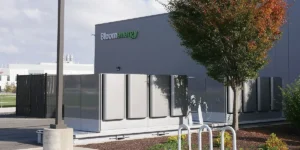How Far Can Hydrogen Go? The Future Fuel Of Long-haul Trucking ~ Hydrogen Fuel News

In recent years, hydrogen has emerged as a popular, alternative zero-emissions fuel. As the world seeks to reduce its carbon footprint, hydrogen is being explored as a possible option for long-haul trucking. Before we take the leap, it’s essential to evaluate its feasibility and consider the benefits and drawbacks of this fuel option. In this context, the long-haul trucking industry has increasingly asked questions such as “Is hydrogen the fuel for long-haul trucking of the future?” and “How can we transition to this fuel option?”
Decarbonizing Long-haul Trucking: The Emerging Role of Hydrogen Insights From Industry Expert
Electric batteries have proven to be one of the best alternatives for decarbonizing light-duty vehicles while ammonia and green methanol are becoming increasingly popular options for marine applications. “Hydrogen is most likely the solution for heavy-duty and long-haul trucking, but the technology is nascent,” highlights Rippan Bhattacharjee, Senior Advisor – Decarbonization at GHD. “The process of minimizing emissions to the maximum possible state using viable, cost-effective technology — which is not crazy expensive —is decarbonization. When considering hydrogen in this category, there are three ways to engage it: blending, fuel cell and a new option, combustion,” adds Bhattacharjee. No matter which format of hydrogen use is selected, the important thing is to take the jump into the hydrogen pool.
Taking the investment plunge
Hydrogen as a vehicle fuel requires a technological investment regardless of deployment due to its unique storage and usage requirements. Financial planning and funding are essential when looking into hydrogen — or any other low-carbon fuel — as an alternative. Our whitepaper, “The Shift: Accelerating Your Fleet Decarbonization Journey,” sheds light on the process of decarbonization, highlighting the importance of estimating costs associated with retrofitting engines or purchasing additional equipment. The whitepaper outlines a 4-step process that takes you from decarbonizing your fleet to creating an actionable plan.
Decarbonization can be costly, but exploring funding options like government grants, subsidies, private investments, stacking options, and partnerships with utility companies is a sound business approach.
Three roads for hydrogen
Hydrogen blending in heavy-duty internal combustion engines (ICEs) can take place with the installation of retrofit kits that include a hydrogen tank and injection technology that directly pumps hydrogen into the engine along with diesel. This has the potential to significantly reduce fossil fuel usage as well as emissions.
On the other hand, fuel cells are essentially electric vehicles batteries, except in this case, a hydrogen stream is charging the battery. When turned on, the battery powers the vehicle like a standard battery electric vehicle would.
While fuel cells combine battery use, combustion doesn’t have that battery, which means there’s an engine that burns hydrogen the same way it would burn diesel fuel.
Sourcing the fuel of the future
Hydrogen might be the best utilization method for this alternative low-emissions fuel choice. “One of the elements to consider when analyzing decarbonizing with an alternative fuel, other than energy needs and fuel pricing, is fuel availability. Under both combustion and fuel cells, hydrogen complies with both characteristics, as it can be affordable and accessible. When thinking about the long term, 20+ years for energy-intensive heavy-duty classes or long-distance vehicles, like long-haul trucking, chances are that they will all run on hydrogen, be it through a fuel cell or combustion,” emphasizes Bhattacharjee.
Although water is the main ingredient for hydrogen mass production, it is still a finite resource and must be handled responsibly and efficiently. Therein lies the matter of finding the balance between accessibility and affordability. There are two primary ways to make hydrogen at scale: electrolysis and steam methane reformation (SMR) . “Electrolysis separates hydrogen and oxygen particles by running electricity through the water, and if the power used for this process comes from a zero-emissions source, then it’s green hydrogen. However, this is a very energy-intensive and inefficient process. In contrast, the most efficient way to produce hydrogen is through SMR, a process that separates natural gas (methane) into carbon and hydrogen that can then be stored. However, this option is more expensive and depends on methane availability, which also limits where the hydrogen can be produced. Globally, SMR is currently utilized to produce up to 95 per cent of all hydrogen supply.
Logistics also play an important role in hydrogen availability. We all know this is a sensitive product, and shipping requirements add to the final price. “A ‘good’ retail price for scale use would be US$10 per kilogram, but due to high import costs, the retail price for hydrogen can reach up to $60 per kilogram. So, for an 80-kilogram tank, even at $10 per kilo, a full tank would add up to $800. The solution for pricing lies either in lowering the price of production and transportation or increasing the demand volume which would lead to a more competitive price,” says Bhattacharjee. Vehicle manufacturers also play a key role in taking the leap into producing commercially available, reliable technology that drives demand for a hydrogen decarbonization transition, which would then enable hydrogen producers to reduce the price using economies of scale.
Going the distance: a decision to decarbonize
Energy agnosticism and an unbiased assessment ensure that pricing or fuel efficiency aren’t the only relevant considerations when deciding to decarbonize long-haul trucking or heavy-duty vehicles with hydrogen. Emissions reduction is the primary driver. Decarbonization is all about minimizing environmental impact from energy-intensive or long-distance uses. So, the key is to find the balance between energy needs, fuel availability and pricing, combined with access to commercially available vehicles.
Our whitepaper, “The Shift: Accelerating your fleet decarbonization journey,” says it loud and clear: we need to identify the juncture where zero-emissions vehicles’ operational cost advantages (OPEX) surpass the initial capital expenditure (CAPEX) associated with these ground-breaking vehicles. This is where we bring into play our proprietary ZEVO™ platform which has been proven to find the most efficient operational scenarios for lower-emission fleets. Click here for more information on the GHD ZEVO platform and for a complete assessment of decarbonization options, along with other insights on transitioning to a low-carbon fleet.




